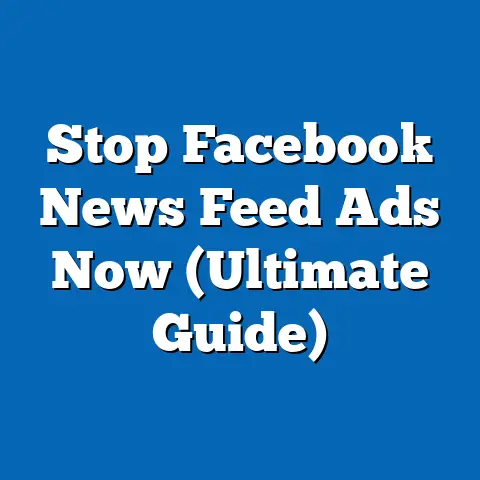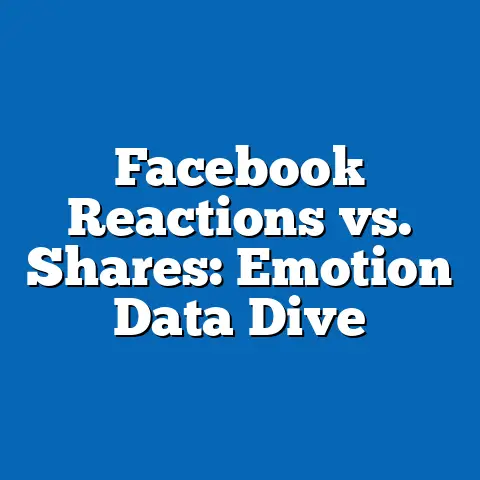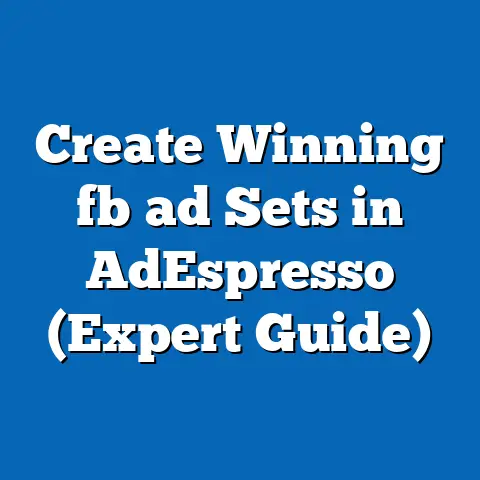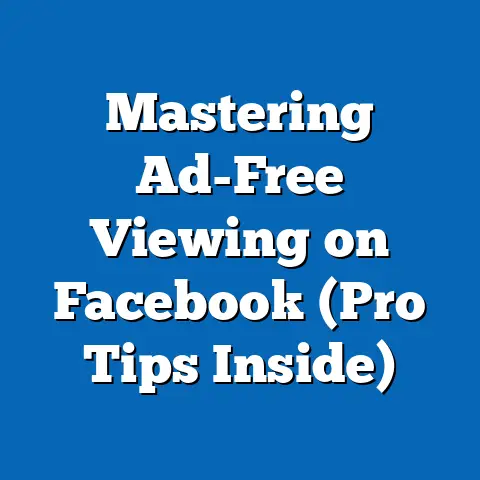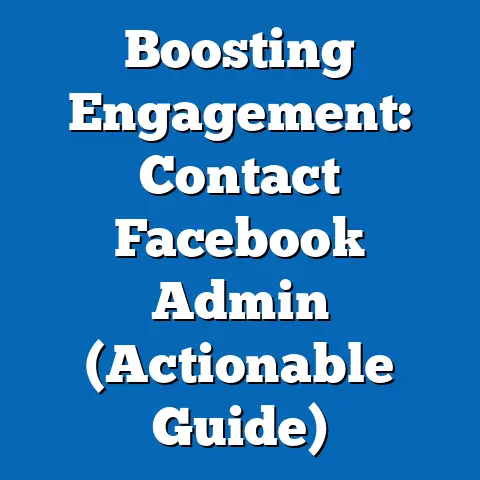Unlocking Facebook Sponsored Ads Success (Proven Strategies)
Facebook advertising. It’s a world I’ve immersed myself in for years, witnessing its evolution from simple banner ads to the sophisticated, data-driven machine it is today. I remember when a good click-through rate was all you needed to call a campaign a success. Now, it’s about so much more: understanding the nuances of the Facebook algorithm, crafting compelling narratives, and leveraging the power of visual storytelling.
In today’s digital landscape, simply throwing up an ad and hoping for the best is a recipe for wasted ad spend. With billions of users scrolling through their feeds daily, capturing attention requires a strategic approach that combines creativity, data analysis, and a deep understanding of your target audience. This guide is designed to provide you with the proven strategies I’ve learned and implemented over the years to unlock success with Facebook sponsored ads. I want to share with you the secrets I’ve found have worked, and the mistakes I’ve learned from. Let’s dive in.
Understanding Facebook’s Advertising Ecosystem
The Facebook advertising ecosystem is a complex yet powerful beast. It’s not just about throwing money at ads; it’s about understanding how the platform works, its various components, and how they all fit together.
Ad Formats: A Variety of Options
Facebook offers a wide array of ad formats, each designed to achieve different objectives. I’ve found that experimenting with different formats is crucial to finding what resonates best with your audience. Here’s a quick rundown:
-
Image Ads: These are the simplest form, featuring a single image and accompanying text. They’re great for showcasing products or services visually. I’ve seen them work particularly well when the image is high-quality and directly relevant to the product.
-
Video Ads: Video ads are incredibly engaging, capturing attention and conveying complex messages in a short amount of time. According to a HubSpot study, video ads generate 1200% more shares than text and image content combined! I’ve found that short, impactful videos perform best.
-
Carousel Ads: These allow you to showcase multiple images or videos in a single ad unit, each with its own headline, description, and link. I often use these to highlight different features of a product or tell a story in a sequence of images.
-
Collection Ads: Designed for e-commerce, collection ads display a catalog of products in a visually appealing format. They’re perfect for driving sales directly from Facebook. I’ve seen great success using collection ads for fashion and home goods brands.
-
Instant Experience Ads: These are full-screen, mobile-optimized experiences that open when someone clicks on your ad. They provide an immersive way to showcase your brand and products. I’ve used them effectively to create interactive product demos.
Image Ads: These are the simplest form, featuring a single image and accompanying text. They’re great for showcasing products or services visually. I’ve seen them work particularly well when the image is high-quality and directly relevant to the product.
Video Ads: Video ads are incredibly engaging, capturing attention and conveying complex messages in a short amount of time. According to a HubSpot study, video ads generate 1200% more shares than text and image content combined! I’ve found that short, impactful videos perform best.
Carousel Ads: These allow you to showcase multiple images or videos in a single ad unit, each with its own headline, description, and link. I often use these to highlight different features of a product or tell a story in a sequence of images.
Collection Ads: Designed for e-commerce, collection ads display a catalog of products in a visually appealing format. They’re perfect for driving sales directly from Facebook. I’ve seen great success using collection ads for fashion and home goods brands.
Instant Experience Ads: These are full-screen, mobile-optimized experiences that open when someone clicks on your ad. They provide an immersive way to showcase your brand and products. I’ve used them effectively to create interactive product demos.
The Algorithm and Targeting Options
Facebook’s algorithm is the invisible hand that determines which ads get shown to which users. Understanding how it works is key to maximizing your ad spend. The algorithm considers factors like ad relevance, bid amount, and estimated action rates to determine which ads to prioritize.
Facebook’s targeting options are incredibly granular, allowing you to reach specific demographics, interests, and behaviors. I’ve been able to target users based on everything from their age and location to their favorite hobbies and purchasing habits. Some of the key targeting options include:
-
Demographic Targeting: Target users based on age, gender, education, job title, and other demographic factors. I often use this for broad-based campaigns aimed at a specific demographic group.
-
Interest Targeting: Target users based on their interests, hobbies, and pages they’ve liked on Facebook. This is great for reaching users who are already interested in your niche.
-
Behavioral Targeting: Target users based on their online behavior, such as their purchasing habits, device usage, and travel patterns. This is particularly useful for reaching users who are likely to convert.
-
Custom Audiences: Upload your own customer lists to create custom audiences. This allows you to target existing customers or create lookalike audiences based on your customer data.
-
Lookalike Audiences: Create audiences that are similar to your existing customers. Facebook uses its data to identify users who share similar characteristics with your customer base. This is one of my favorite strategies for expanding reach and finding new customers.
Demographic Targeting: Target users based on age, gender, education, job title, and other demographic factors. I often use this for broad-based campaigns aimed at a specific demographic group.
Interest Targeting: Target users based on their interests, hobbies, and pages they’ve liked on Facebook. This is great for reaching users who are already interested in your niche.
Behavioral Targeting: Target users based on their online behavior, such as their purchasing habits, device usage, and travel patterns. This is particularly useful for reaching users who are likely to convert.
Custom Audiences: Upload your own customer lists to create custom audiences. This allows you to target existing customers or create lookalike audiences based on your customer data.
Lookalike Audiences: Create audiences that are similar to your existing customers. Facebook uses its data to identify users who share similar characteristics with your customer base. This is one of my favorite strategies for expanding reach and finding new customers.
The Facebook Ads Manager
The Facebook Ads Manager is your central hub for creating, managing, and tracking your ad campaigns. It provides a comprehensive suite of tools for:
-
Creating Ads: Design and build your ads using a variety of templates and customization options.
-
Setting Budgets and Bids: Define your daily or lifetime budget and choose your bidding strategy.
-
Targeting Audiences: Select your target audience based on demographics, interests, behaviors, and custom audiences.
-
Tracking Performance: Monitor key metrics like impressions, clicks, conversions, and return on ad spend (ROAS).
-
Optimizing Campaigns: Make adjustments to your ads, targeting, and bidding based on performance data.
Creating Ads: Design and build your ads using a variety of templates and customization options.
Setting Budgets and Bids: Define your daily or lifetime budget and choose your bidding strategy.
Targeting Audiences: Select your target audience based on demographics, interests, behaviors, and custom audiences.
Tracking Performance: Monitor key metrics like impressions, clicks, conversions, and return on ad spend (ROAS).
Optimizing Campaigns: Make adjustments to your ads, targeting, and bidding based on performance data.
Takeaway: Understanding the Facebook advertising ecosystem, its various ad formats, targeting options, and the Facebook Ads Manager is essential for creating successful campaigns. Experiment with different formats and targeting options to find what works best for your audience.
Crafting Compelling Ad Content
Content is king, especially in the crowded landscape of Facebook advertising. Your ad copy needs to grab attention, convey your message clearly, and compel users to take action.
The Power of Storytelling
Storytelling is one of the most effective ways to connect with your audience on an emotional level. Instead of simply listing features and benefits, tell a story that resonates with their needs and aspirations.
I remember working with a local bakery that wanted to promote their new line of artisanal breads. Instead of just showing pictures of the bread, we created a series of ads that told the story of the baker, his passion for using local ingredients, and the traditional techniques he used to create the bread. These ads resonated deeply with the community, driving a significant increase in sales.
Here are some tips for incorporating storytelling into your ad copy:
-
Identify Your Audience’s Pain Points: What are their challenges, needs, and desires?
-
Create a Narrative: Craft a story that addresses those pain points and offers a solution.
-
Use Emotional Language: Evoke emotions that resonate with your audience.
-
Keep it Concise: Facebook users have short attention spans, so keep your story brief and to the point.
Identify Your Audience’s Pain Points: What are their challenges, needs, and desires?
Create a Narrative: Craft a story that addresses those pain points and offers a solution.
Use Emotional Language: Evoke emotions that resonate with your audience.
Keep it Concise: Facebook users have short attention spans, so keep your story brief and to the point.
Persuasive Headlines and Descriptions
Your headline and description are the first things users see, so they need to be compelling enough to grab their attention. Here are some tips for writing persuasive headlines and descriptions:
-
Use Strong Verbs: Start with action verbs that create a sense of urgency and excitement.
-
Highlight Benefits: Focus on the benefits of your product or service, not just the features.
-
Ask Questions: Engage users by asking questions that pique their curiosity.
-
Use Numbers and Statistics: Numbers and statistics can add credibility and make your claims more believable.
-
Create a Sense of Urgency: Use words like “limited time offer” or “sale ends soon” to encourage immediate action.
Use Strong Verbs: Start with action verbs that create a sense of urgency and excitement.
Highlight Benefits: Focus on the benefits of your product or service, not just the features.
Ask Questions: Engage users by asking questions that pique their curiosity.
Use Numbers and Statistics: Numbers and statistics can add credibility and make your claims more believable.
Create a Sense of Urgency: Use words like “limited time offer” or “sale ends soon” to encourage immediate action.
Clear Calls-to-Action (CTAs)
Your call-to-action (CTA) is the final nudge that compels users to take the desired action. Make sure your CTA is clear, concise, and relevant to the ad.
Some effective CTAs include:
-
Shop Now: Perfect for e-commerce ads.
-
Learn More: Ideal for ads that provide information or educational content.
-
Sign Up: Great for building your email list.
-
Download Now: Use this for promoting ebooks, apps, or other digital products.
-
Contact Us: Use this for generating leads.
Shop Now: Perfect for e-commerce ads.
Learn More: Ideal for ads that provide information or educational content.
Sign Up: Great for building your email list.
Download Now: Use this for promoting ebooks, apps, or other digital products.
Contact Us: Use this for generating leads.
I’ve found that testing different CTAs can significantly impact conversion rates. Experiment with different wording and placement to find what works best for your audience.
User-Generated Content and Testimonials
User-generated content (UGC) and testimonials are powerful tools for building trust and credibility. When potential customers see that others have had positive experiences with your product or service, they’re more likely to make a purchase.
Here are some ways to incorporate UGC and testimonials into your ads:
-
Feature Customer Reviews: Showcase positive reviews and ratings in your ads.
-
Share Customer Photos and Videos: Ask customers to share photos and videos of themselves using your product.
-
Run Contests and Giveaways: Encourage users to create content related to your brand in exchange for a chance to win a prize.
Feature Customer Reviews: Showcase positive reviews and ratings in your ads.
Share Customer Photos and Videos: Ask customers to share photos and videos of themselves using your product.
Run Contests and Giveaways: Encourage users to create content related to your brand in exchange for a chance to win a prize.
Takeaway: Crafting compelling ad content is crucial for capturing attention and driving engagement. Use storytelling, persuasive headlines, clear CTAs, and user-generated content to create ads that resonate with your target audience.
Visual Elements that Drive Engagement
In the visually-driven world of Facebook, your ad’s visual elements are often the first thing users notice. A compelling visual can stop the scroll and draw users in, while a poorly designed visual can send them scrolling past.
The Power of Color, Fonts, and Imagery
Color, fonts, and imagery play a crucial role in conveying your brand’s message and attracting attention. Here are some tips for using these elements effectively:
-
Color Psychology: Understand the psychology of colors and how they can influence emotions. For example, blue often conveys trust and reliability, while red conveys excitement and urgency.
-
Font Selection: Choose fonts that are legible, visually appealing, and consistent with your brand identity. Avoid using too many different fonts in a single ad.
-
High-Quality Imagery: Use high-resolution images that are clear, well-lit, and relevant to your product or service. Avoid using stock photos that look generic or staged.
Color Psychology: Understand the psychology of colors and how they can influence emotions. For example, blue often conveys trust and reliability, while red conveys excitement and urgency.
Font Selection: Choose fonts that are legible, visually appealing, and consistent with your brand identity. Avoid using too many different fonts in a single ad.
High-Quality Imagery: Use high-resolution images that are clear, well-lit, and relevant to your product or service. Avoid using stock photos that look generic or staged.
I’ve found that A/B testing different color schemes and font combinations can significantly impact ad performance.
Aligning Visuals with Brand Identity
Your visuals should be consistent with your brand identity, including your logo, colors, fonts, and overall aesthetic. This helps to create a cohesive brand experience and build brand recognition.
I worked with a luxury skincare brand that wanted to create a more consistent brand identity across their Facebook ads. We created a style guide that outlined their brand colors, fonts, and imagery guidelines. By adhering to these guidelines, we were able to create ads that were instantly recognizable and aligned with their brand values.
Effective Video Content
Video ads are incredibly engaging, but they need to be well-produced and optimized for Facebook. Here are some tips for creating effective video content:
-
Keep it Short: Facebook users have short attention spans, so keep your videos short and to the point. Aim for videos that are 15-30 seconds long.
-
Capture Attention Quickly: The first few seconds of your video are crucial. Start with a visually compelling scene or a captivating hook.
-
Tell a Story: Use storytelling to connect with your audience on an emotional level.
-
Use Captions: Many Facebook users watch videos with the sound off, so use captions to ensure your message is understood.
-
Optimize for Mobile: Most Facebook users access the platform on their mobile devices, so optimize your videos for mobile viewing.
Keep it Short: Facebook users have short attention spans, so keep your videos short and to the point. Aim for videos that are 15-30 seconds long.
Capture Attention Quickly: The first few seconds of your video are crucial. Start with a visually compelling scene or a captivating hook.
Tell a Story: Use storytelling to connect with your audience on an emotional level.
Use Captions: Many Facebook users watch videos with the sound off, so use captions to ensure your message is understood.
Optimize for Mobile: Most Facebook users access the platform on their mobile devices, so optimize your videos for mobile viewing.
Eye-Catching Thumbnails and Images
Your thumbnail is the image that appears before users click on your video. It needs to be eye-catching and relevant to the video content.
Here are some tips for creating eye-catching thumbnails and images:
-
Use Bright Colors: Use bright colors that stand out in the feed.
-
Include Text: Add text to your thumbnail that summarizes the video content.
-
Use Faces: Images with faces tend to be more engaging.
-
Keep it Simple: Avoid cluttering your thumbnail with too many elements.
Use Bright Colors: Use bright colors that stand out in the feed.
Include Text: Add text to your thumbnail that summarizes the video content.
Use Faces: Images with faces tend to be more engaging.
Keep it Simple: Avoid cluttering your thumbnail with too many elements.
Takeaway: Visual elements play a crucial role in capturing attention and driving engagement. Use color, fonts, and imagery strategically, align visuals with your brand identity, and create effective video content with eye-catching thumbnails and images.
Targeting the Right Audience
Targeting the right audience is critical for maximizing the effectiveness of your ad campaigns. Showing your ads to the wrong people is a surefire way to waste your ad spend.
Audience Segmentation
Audience segmentation involves dividing your target audience into smaller, more specific groups based on shared characteristics. This allows you to create ads that are tailored to the specific needs and interests of each group.
Here are some ways to segment your audience:
-
Demographics: Segment by age, gender, location, education, and job title.
-
Interests: Segment by hobbies, interests, and pages they’ve liked on Facebook.
-
Behaviors: Segment by online behavior, such as purchasing habits, device usage, and travel patterns.
-
Customer Data: Segment based on your existing customer data, such as purchase history, demographics, and engagement with your brand.
Demographics: Segment by age, gender, location, education, and job title.
Interests: Segment by hobbies, interests, and pages they’ve liked on Facebook.
Behaviors: Segment by online behavior, such as purchasing habits, device usage, and travel patterns.
Customer Data: Segment based on your existing customer data, such as purchase history, demographics, and engagement with your brand.
Defining Target Audiences
Facebook’s detailed targeting options allow you to define your target audiences with incredible precision. You can target users based on:
-
Location: Target users based on their country, region, city, or even specific address.
-
Age: Target users based on their age range.
-
Gender: Target users based on their gender.
-
Language: Target users based on the languages they speak.
-
Education: Target users based on their education level.
-
Job Title: Target users based on their job title.
-
Interests: Target users based on their interests, hobbies, and pages they’ve liked on Facebook.
-
Behaviors: Target users based on their online behavior, such as purchasing habits, device usage, and travel patterns.
Location: Target users based on their country, region, city, or even specific address.
Age: Target users based on their age range.
Gender: Target users based on their gender.
Language: Target users based on the languages they speak.
Education: Target users based on their education level.
Job Title: Target users based on their job title.
Interests: Target users based on their interests, hobbies, and pages they’ve liked on Facebook.
Behaviors: Target users based on their online behavior, such as purchasing habits, device usage, and travel patterns.
Retargeting and Lookalike Audiences
Retargeting involves showing ads to users who have already interacted with your brand, such as visiting your website or engaging with your Facebook page. This is a highly effective strategy for driving conversions, as these users are already familiar with your brand.
Lookalike audiences allow you to create audiences that are similar to your existing customers. Facebook uses its data to identify users who share similar characteristics with your customer base. This is a great way to expand your reach and find new customers.
I’ve found that combining retargeting and lookalike audiences can significantly boost ad performance.
Takeaway: Targeting the right audience is crucial for maximizing the effectiveness of your ad campaigns. Use audience segmentation, Facebook’s detailed targeting options, retargeting, and lookalike audiences to reach the people who are most likely to be interested in your product or service.
Analyzing and Optimizing Ad Performance
Creating effective Facebook ads is an ongoing process that involves continuous analysis and optimization. You need to track your ad performance, identify what’s working and what’s not, and make adjustments accordingly.
Key Performance Indicators (KPIs)
Key performance indicators (KPIs) are metrics that you use to track the performance of your ad campaigns. Some of the most important KPIs include:
-
Impressions: The number of times your ad is shown.
-
Reach: The number of unique users who see your ad.
-
Click-Through Rate (CTR): The percentage of users who click on your ad.
-
Conversion Rate: The percentage of users who take the desired action, such as making a purchase or signing up for a newsletter.
-
Cost Per Click (CPC): The average cost you pay for each click on your ad.
-
Cost Per Conversion (CPC): The average cost you pay for each conversion.
-
Return on Ad Spend (ROAS): The amount of revenue you generate for every dollar you spend on advertising.
Impressions: The number of times your ad is shown.
Reach: The number of unique users who see your ad.
Click-Through Rate (CTR): The percentage of users who click on your ad.
Conversion Rate: The percentage of users who take the desired action, such as making a purchase or signing up for a newsletter.
Cost Per Click (CPC): The average cost you pay for each click on your ad.
Cost Per Conversion (CPC): The average cost you pay for each conversion.
Return on Ad Spend (ROAS): The amount of revenue you generate for every dollar you spend on advertising.
A/B Testing
A/B testing involves creating two or more versions of your ad and testing them against each other to see which performs best. You can A/B test different headlines, descriptions, images, videos, CTAs, and targeting options.
I always recommend A/B testing as many elements as possible to identify what resonates best with your audience.
Adjusting Budgets and Bids
Based on your ad performance data, you may need to adjust your budgets and bids to maximize your ROI. If you’re seeing a high ROAS on a particular campaign, you may want to increase your budget to reach more users. If you’re seeing a low ROAS, you may want to decrease your budget or adjust your bidding strategy.
Takeaway: Analyzing and optimizing ad performance is an ongoing process that involves tracking KPIs, A/B testing, and adjusting budgets and bids. By continuously monitoring your ad performance and making adjustments accordingly, you can maximize your ROI and achieve your advertising goals.
Conclusion
Unlocking success with Facebook sponsored ads requires a strategic approach that combines creativity, data analysis, and a deep understanding of your target audience. By understanding the Facebook advertising ecosystem, crafting compelling ad content, using engaging visuals, targeting the right audience, and continuously analyzing and optimizing your ad performance, you can unlock the full potential of Facebook advertising and achieve your business goals.
I’ve seen firsthand how these strategies can transform a struggling campaign into a roaring success. It takes dedication, experimentation, and a willingness to learn and adapt. So, take these proven strategies, apply them to your own campaigns, and watch your results soar. The world of Facebook advertising is constantly evolving, but the core principles of effective marketing remain the same: understand your audience, create compelling content, and continuously optimize your efforts. Good luck, and happy advertising!

